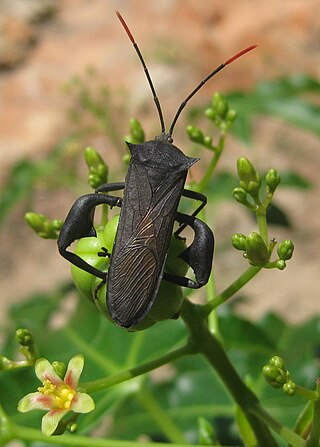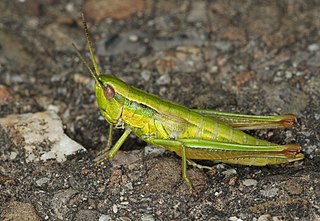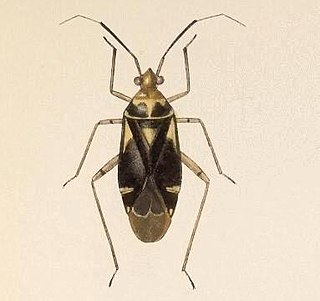
Pyrrhocoridae is a family of insects with more than 300 species world-wide. Many are red coloured and are known as red bugs and some species are called cotton stainers because their feeding activities leave an indelible yellow-brownish stain on cotton crops. A common species in parts of Europe is the firebug, and its genus name Pyrrhocoris and the family name are derived from the Greek roots for fire "pyrrho-" and bug "coris". Members of this family are often confused with, but can be quickly separated from, Lygaeidae by the lack of ocelli on the top of the head.

Coreidae is a large family of predominantly sap-sucking insects in the Hemipteran suborder Heteroptera. The name "Coreidae" derives from the genus Coreus, which derives from the Ancient Greek κόρις (kóris) meaning bedbug.

Apiomerus is a genus of conspicuous, brightly colored assassin bugs belonging to the family Reduviidae. The species can be found in the United States ranging into tropical America. The common name bee assassins derives from their frequent habit of sitting and waiting upon flowers and taking bees as prey. The bright colors are aposematic, likely a warning to larger predators that a painful bite can be delivered.
Diadema is the term for diadem in most Romance languages, and in English may refer to:

Zelus is a genus of insects in the family Reduviidae, the assassin bugs. There are currently 60 described species; most occur in Central and South America, and five are found in North America.

The Harpactorinae are a large subfamily of the Reduviidae. About 300 genera and 2,000 species worldwide have been described. Some of the species of the genera Zelus, Pselliopus, Sinea, and Apiomerus are of interest as biological pest control agents.

Harpactorini is a tribe of the Harpactorinae. This group is the most diverse of the entire assassin bug family, with 51 genera recognized in the Neotropical Region and 289 genera and 2003 species overall.

Gomphocerinae, sometimes called "slant-faced grasshoppers", are a subfamily of grasshoppers found on every continent but Antarctica and Australia.

Pselliopus is a common genus of assassin bugs (Reduviidae), in the subfamily Harpactorinae. The genus is restricted to the New World, with 27 species described. Some species, such as Pselliopus barberi, are conspicuous because of their bright coloring and relatively large size. Some species of the genus are of interest as potential biological pest control agents.

Sinea diadema is a species of assassin bug family (Reduviidae), in the subfamily Harpactorinae. Sinea diadema is bivoltine, preys on small bugs and beetles, and overwinters in the egg stage.

Poecilocapsus is a genus of bugs in the family Miridae. The size of these species is from 6–8 millimetres (0.24–0.31 in) and can be found in North America.

Thasus is an insect genus of the Coreidae, or leaf-footed bugs. It is a genus in the New World Nematopodini tribe that feeds on plants. It is chiefly found in Central America, but species also occur in South America, and as far north as the American Southwest.

Bactrodes is a genus of reduviids. All known species are from South America.

Pnirontis is a genus of assassin bugs in the family Reduviidae. There are more than 30 described species in Pnirontis.
Doldina is a genus of assassin bugs in the family Reduviidae. There are about eight described species in Doldina.

Mozena is a genus of leaf-footed bugs in the family Coreidae. There are more than 30 described species in Mozena.

Hoplistoscelis is a genus of damsel bugs in the family Nabidae. There are about eight described species in Hoplistoscelis.

Sinea coronata is a species of assassin bug in the family Reduviidae. It is found in the Caribbean Sea, Central America, and North America.
Ctenotrachelus is a genus of assassin bugs in the family Reduviidae. There are more than 20 described species in Ctenotrachelus.
Rocconota is a genus of assassin bugs in the family Reduviidae. There are about 10 described species in Rocconota.















